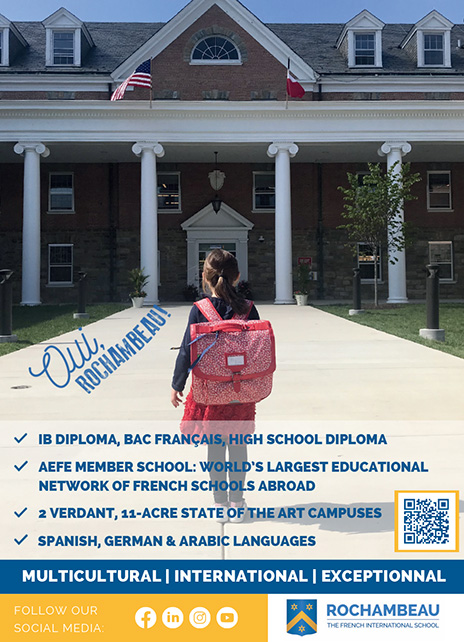What to Know When Considering French Schools
Choices abound when considering the French school system for your child. Here are some tips to help guide your decision-making.
BY MARTIN THOMEN

iStockPhoto / Qvasimodo
Some U.S. foreign affairs professionals educate their children in the French school system, an option in cities of many foreign and domestic assignments. Choices abound, from public bilingual schools in the Washington, D.C., area to a worldwide network of French-government schools on six continents. Motivations for choosing French vary: For some, it’s a bridge to a cultural or family connection, and for others, it’s a decision made with future opportunities in mind.
French school families rely on the trusted network of the State Department’s Office of Overseas Schools’ regional education officers, post resources, and tips from other families, but they face additional challenges and benefits specific to the French school system.
The French School System: Nuts and Bolts
French schools are divided into maternelle, école primaire, collège, and lycée with grade levels corresponding to the U.S. grade levels as noted in the table (page opposite).
While some schools may make changes for local conditions, the standard is that to begin in the system, the child must turn 5 years old by Dec. 31 of the year of enrollment to grande section (GS). In other words, 4-year-olds turning 5 between the fall school start date and end of the calendar year normally may enter GS.
French schools will accept new students with little or no French language ability through first grade cours préparatoire (CP), although most require French language skills for children enrolling in levels beyond CP.
For families considering enrollment in the French system, a good tip is to start in the system as early as possible in the child’s education journey.
AEFE and Non-AEFE Options
The government of France created the Agency for French Education Abroad (AEFE) in 1990 to coordinate and manage the network of French schools outside France. There are 580 French schools worldwide with almost 392,000 students, 65 percent of whom are not French citizens, in 139 countries.
AEFE oversight results in a uniformity of curriculum and standards across the network of schools. Students in AEFE schools may seamlessly transfer to other AEFE schools worldwide without the need to translate documents or determine equivalencies across class and grade results.
There are 580 French schools worldwide with almost 392,000 students, 65 percent of whom are not French citizens, in 139 countries.
French-language school choices exist outside the AEFE system as well. These may be local schools in a country or province that is French-speaking or locally run French-language immersion schools, including those in Washington, D.C., and other locales.
Transferring between non-AEFE and AEFE schools may involve meeting requirements of the receiving school for testing in or determining equivalencies of classes transferred.
Montgomery County Schools’ Sligo Creek Elementary and Fairfax County Public Schools’ Kent Gardens Elementary are examples of non-AEFE French-language immersion schools in the Washington, D.C., area.
Parents considering French-language schooling should determine whether schools in their preferred location are non-AEFE or AEFE-certified and talk to counselors about requirements for district enrollment, testing in, or transferring credits.
| School | U.S. System | French System |
|---|---|---|
| Nursery, Maternelle | Pre-K | Moyenne Section (MS) |
| Kindergarten | Grande Section (GS) | |
| Lower/Primary, École Primaire | First Grade | Cours Préparatoire (CP) |
| Second Grade | Cours Elémentaire 1 (CE1) | |
| Third Grade | Cours Elémentaire 2 (CE2) | |
| Fourth Grade | Cours Moyen 1 (CM1) | |
| Fifth Grade | Cours Moyen 2 (CM2) | |
| Middle, Collège | Sixth Grade | Sixième (6ème) |
| Seventh Grade | Cinquième (5ème) | |
| Eighth Grade | Quatrième (4ème) | |
| Ninth Grade | Troisième (3ème) | |
| Upper/High, Lycée | Tenth Grade | Seconde (2nde) |
| Eleventh Grade | Première (1ère) | |
| Twelfth Grade | Terminale (Tle) |
French Education Pros and Cons
Top Tips & Resources
- Get into the system as early as possible in the child’s education journey.
- Determine whether schools are non-AEFE or AEFE, and talk to counselors about requirements for enrollment, testing in, or transferring credits.
- Find a map of worldwide schools and more at the Agency for French Education Abroad’s website: https://aefe.gouv.fr/.
- Join the conversation with other U.S. personnel with children in, or interested in, French education on Facebook.
- Talk to the school counselor, Office of Overseas Schools, and post representatives about your school choice.
As with any school choice, positives and negatives exist. Here are some of the pros and cons, based on the recent experiences of U.S. Foreign Service families with children in the French school system.
Pros: AEFE-certified schools provide a direct pathway to completion of the French baccalauréat (le bac) exams that are taken over the last two years of high school. Leading universities in the United States, Canada, Europe, and beyond recognize le bac as a high-quality and rigorous qualification for university entry.
Additionally, many French schools offer high schoolers a track to the international baccalaureate (IB), a local high school degree program, or other university-entry programs such as advanced placement (AP). For instance, Rochambeau, an AEFE-certified school in Bethesda, Maryland, offers AP courses, and graduating seniors earn a dual degree: a Maryland high school diploma and le bac.
In many foreign capitals, the tuition of the French school is more affordable than other international schools, allowing for a healthy mix of local and international culture. The French government via AEFE often provides financial support to these schools.
The centralization of the curriculum and grading makes for smooth transitions between posts for students staying in the French system.
Cons: If the parents don’t have French-language skills, it can create a disconnect when assisting with schoolwork or volunteering at the school. Similarly, the “playground language” may principally be the host country’s local language or French, which can be a challenge for early learners.
Overseas, French schools are not normally the “post-supported” school (they may be a “post-assisted” school). It is important to understand the difference. Because post’s management section, Regional Security Officer, and Community Liasion Officer may have more mandatory duties related to the supported school (such as financial support and safety oversight), non-supported schools may naturally have less direct interaction with post. And that may require more parental communication and advocacy on issues that crop up at a post-assisted French school than at a post-supported school.
If you plan to transfer out of the French system or move to a post without a French school, you may need to translate and gain equivalency scores for prior coursework.
When sharing or linking to FSJ articles online, which we welcome and encourage, please be sure to cite the magazine (The Foreign Service Journal) and the month and year of publication. Please check the permissions page for further details.
Read More...
- “Multilingual Matters: How FS Students Can Make the Most of Language-Rich Experiences Abroad” by Marybeth Hunter and Christine Brown, The Foreign Service Journal, December 2015
- “Raising Multilingual Children in the Foreign Service” by Nichole Shaefer-McDaniel and Jennifer Kirk Dinoia, The Foreign Service Journal, December 2017
- “The French education system,” France Education International, 2025





